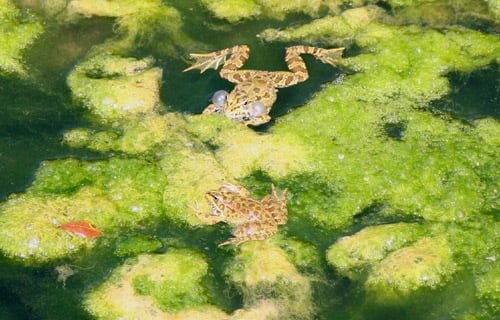- English: Iberian Water Frog
- Scientific: Pelophylax perezi
- Spanish: Rana común
- Portuguese: Rá-verde
- Distribution: All of Iberia
The Iberian Water Frog – Pelophylax perezi – Rana común is rarely very far from water, they will inhabit lakesides, ponds, slow rivers, canals, marshes, moors, rice fields, man made water deposits and troughs up to an altitude of 2,400m. They will often sit at the waters edge and hop in if disturbed. They are active both day and night though most vocal in the evening.

The Iberian Water Frogs are from 35 – 90 mm in body length, (occasionally reaching 100mm) with the females being the largest. Their colour variation is huge, covering many shades of greys, greens and browns, sometimes with darker blotches and with warts or smooth. The underside is off-white occasionally bearing brown / charcoal speckles.
They often have a central dorsal stripe of a pale colour beginning at the tip of their long pointed snout. The eyes consist of a horizontal pupil surrounded by a golden colour, just behind the eye on the males is a visible vocal sac. The dorso-lateral folds are very visible and can be of a differing colour to the main body. The hind legs are quite long with the heel reaching past the eye. The fore feet have four toes, the hind feet five with well developed webbing.

This species of frog can hibernate in the water or on land. If seen away from water this is generally the younger ones.
These frogs feed on insects, spiders, small fish plus other amphibians. The tadpoles feed mainly on vegetation and ants but also eat micro-organisms.
Breeding may be over an extended period. Firstly the female selects a male by his ability to sing. The eggs are fertilized by the male as they leave the female. Each egg is around 6 to 8mm and laid in clusters of from 800 to 10,000.

The emerging tadpoles measure about 4 to 6 mm long when they first hatch, reaching a size of about 50 to 70 mm long. The tail is deepest in the centre and tapers to a point. The body and tail are a speckled and blotched golden brown colour with a paler, whitish underside.
The time it takes them to metamorphose depends on the water body that they are in and the time of year. If the water is shallow and poorly oxygenated with a risk of drying up they will develop more quickly into tiny froglets. Conversely if the eggs hatch at the end of summer and there is plenty of water, they can over winter as tadpoles which reach a greater size before changing.
.
The maximum life span for an Iberian Water Frog is about 10 years and they reach their sexual maturity in their second year for the males, third year for females.
More reptiles and amphibians of Spain here.
Iberia Nature Forum
Struggling with identifying those bugs and beasties? Why not check out the Iberia nature Forum!
Discover the Iberia Nature Forum – Environment, geography, nature, landscape, climate, culture, history, rural tourism and travel.
I’ve been living in this lovely area of Western Andalucia for the last 20 years or so and dedicate most of my time to the running of English language tourist information websites for the towns of Cádiz, Ronda, Grazalema, the famous or infamous Caminito del Rey, and also Wildside Holidays, which promotes sustainable and eco-friendly businesses running wildlife and walking holidays in Spain. My articles contain affiliate links that will help you reserve a hotel, bus, train or activity in the area. You don’t pay more, but by using them you do support this website. Thankyou!

1 thought on “Iberian Water Frog – Pelophylax perezi – Rana común”